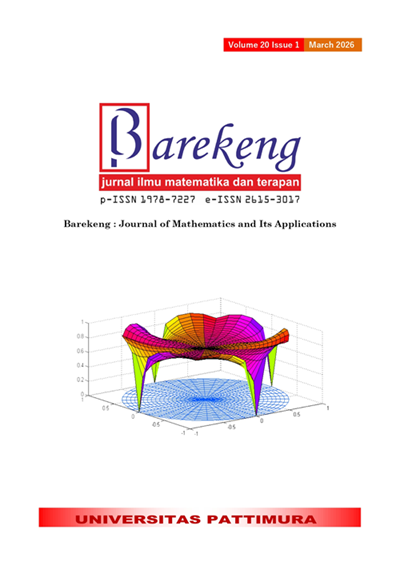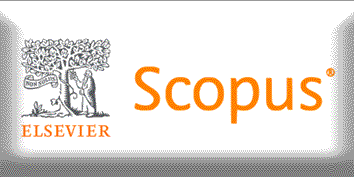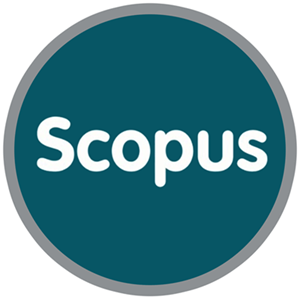MAPPING DISASTER-PRONE AREAS ON JAVA ISLAND USING THE K-PROTOTYPES ALGORITHM
Abstract
Clustering in disaster areas is often implemented as a disaster mitigation effort with the aim of minimizing risk. Determining the appropriate clustering method based on the data set will influence the clustering results. K-Prototypes is a clustering method that is capable of handling mixed data, numerical and categorical data, so this method is suitable to clustering disaster prone area with mixed data of disaster factors such as incident intensity, type of disaster, population density, and level of infrastructure vulnerability. This research focuses on disaster prone areas on Java Island and clustering using K-Prototypes to group and map areas that have the highest to lowest levels of disaster vulnerability based on the number of incidents, number of victims, and the amount of damage to facilities and the type of disaster. The clustering results obtained mapping of cities in the province into cluster groups based on the level of vulnerability and calculated potential losses based on disasters in each province. Afterward, the clustering results are used to determine priority areas for disaster mitigation to minimize losses.
Downloads
References
Indonesia’s National Disaster Management Agency, GEOPORTAL DATA BENCANA INDONESIA. Jakarta: Indonesia’s National Disaster Management Agency, 2022.
A. F. Pohan et al., “UTILIZATION AND MODELING OF SATELLITE GRAVITY DATA FOR GEOHAZARD ASSESSMENT IN THE YOGYAKARTA AREA OF JAVA ISLAND, INDONESIA,” Kuwait J. Sci., vol. 50, no. 4, pp. 499–511, Oct. 2023, doi: https://doi.org/10.1016/j.kjs.2023.05.016.
PUSGEN, “PETA BAHAYA GEMPA INDONESIA,” Pusat Studi Gempa Nasional, 2017.
R. Muliono and S. Z, “DATA MINING CLUSTERING MENGGUNAKAN ALGORITMA K-MEANS UNTUK KLASTERISASI TINGKAT TRIDHARMA PENGAJARAN DOSEN,” CESS J. Comput. Eng. Syst. Sci., vol. 4, no. 2, pp. 272–279, 2019.
M. Bennett, E. J. Kleczyk, K. Hayes, and R. Mehta, “EVALUATING SIMILARITIES AND DIFFERENCES BETWEEN MACHINE LEARNING AND TRADITIONAL STATISTICAL MODELING IN HEALTHCARE ANALYTICS,” in Artificial Intelligence, vol. 12, M. Antonio Aceves Fernandez and C. M. Travieso-Gonzalez, Eds., IntechOpen, 2022. doi: https://doi.org/10.5772/intechopen.105116.
S. Annas, I. Irwan, R. H. Safei, and Z. Rais, “K-PROTOTYPES ALGORITHM FOR CLUSTERING THE TECTONIC EARTHQUAKE IN SULAWESI ISLAND,” J. Varian, vol. 5, no. 2, pp. 191–198, May 2022, doi: https://doi.org/10.30812/varian.v5i2.1908.
M. Refaldy, S. Annas, and Z. Rais, “K-PROTOTYPE ALGORITHM IN GROUPING REGENCY/CITY IN SOUTH SULAWESI PROVINCE BASED ON 2020 PEOPLE’S WELFARE,” ARRUS J. Math. Appl. Sci., vol. 3, no. 1, pp. 11–19, May 2023, doi: https://doi.org/10.35877/mathscience1763.
O. U. Mehmood, Yap Bee Wah, and W. F. Wan Yaacob, Eds., DECISION MATHEMATICS, STATISTICAL LEARNING AND DATA MINING: SELECTED CONTRIBUTIONS FROM ICMSCT2023, Manila, Philippines, September 20-21. in Springer Proceedings in Mathematics & Statistics, no. volume 461. Singapore: Springer Nature Singapore, 2024.
M. A. Bramer, PRINCIPLES OF DATA MINING, 3rd ed. 2016. in Undergraduate Topics in Computer Science. London: Springer, 2016. doi: https://doi.org/10.1007/978-1-4471-7307-6.
P.-N. Tan, M. Steinbach, A. Karpatne, and V. Kumar, INTRODUCTION TO DATA MINING, Second edition, Global edition. Harlow: Pearson Education, 2019.
E. Muningsih and Kiswati, S, “PENERAPAN METODE K-MEANS UNTUK CLUSTERING PRODUK ONLINE SHOP DALAM PENENTUAN STOK BARANG,” Bianglala Inform., vol. 3, no. 1, pp. 1–11, 2015.
P. Fränti and S. Sieranoja, “HOW MUCH CAN K-MEANS BE IMPROVED BY USING BETTER INITIALIZATION AND REPEATS?,” Pattern Recognit., vol. 93, pp. 95–112, Sep. 2019, doi: https://doi.org/10.1016/j.patcog.2019.04.014.
K. M. P. Dewi, M. L. Tauryawati, and A. F. Zainuddin, “CLUSTERING OF DISASTER PRONES AREAS IN JAVA ISLAND,” presented at the RECENT ADVANCES IN MATERIALS AND MANUFACTURING: ICRAMM2023, Erode, India, 2024, p. 020003. doi: https://doi.org/10.1063/5.0230700.
STMIK STIKOM Indonesia, D. A. I. C. Dewi, D. A. K. Pramita, and STMIK STIKOM Indonesia, “ANALISIS PERBANDINGAN METODE ELBOW DAN SILHOUETTE PADA ALGORITMA CLUSTERING K-MEDOIDS DALAM PENGELOMPOKAN PRODUKSI KERAJINAN BALI,” Matrix J. Manaj. Teknol. Dan Inform., vol. 9, no. 3, pp. 102–109, Nov. 2019, doi: https://doi.org/10.31940/matrix.v9i3.1662.
S. Aisah, I. Aknuranda, and A. N. Rusydi, “SISTEM PENDUKUNG KEPUTUSAN UNTUK PENGELOMPOKAN BARANG TERJUAL PADA PT DASEMA DIGI PERSADA DENGAN METODE K-MEANS CLUSTERING,” J. Pengemb. Teknol. Inf. Dan Ilmu Komput., vol. 4, no. 7, pp. 2309–2317, 2020.
G. Vardakas, I. Papakostas, and A. Likas, “DEEP CLUSTERING USING THE SOFT SILHOUETTE SCORE: TOWARDS COMPACT AND WELL-SEPARATED CLUSTERS,” 2024, arXiv. doi: 10.48550/ARXIV.2402.00608.
M. Gagolewski, M. Bartoszuk, and A. Cena, “ARE CLUSTER VALIDITY MEASURES (IN) VALID?,” Inf. Sci., vol. 581, pp. 620–636, Dec. 2021, doi: https://doi.org/10.1016/j.ins.2021.10.004.
D. L. Davies and D. W. Bouldin, “A CLUSTER SEPARATION MEASURE,” IEEE Trans. Pattern Anal. Mach. Intell., vol. PAMI-1, no. 2, pp. 224–227, Apr. 1979, doi: https://doi.org/10.1109/TPAMI.1979.4766909.
A. Hamadani et al., “OUTLIER REMOVAL IN SHEEP FARM DATASETS USING WINSORIZATION,” Bhartiya Krishi Anusandhan Patrika, no. Of, Jan. 2022, doi: https://doi.org/10.18805/BKAP397.
Abuzaid, “A COMPARATIVE STUDY ON UNIVARIATE OUTLIER WINSORIZATION METHODS IN DATA SCIENCE CONTEXT,” Stat. Appl. – Ital. J. Appl. Stat., vol. 36, no. 1, p. 1, 2024, doi: 10.26398/IJAS.0036-004.
Copyright (c) 2025 Mey Lista Tauryawati, Ahmad Fuad Zainuddin

This work is licensed under a Creative Commons Attribution-ShareAlike 4.0 International License.
Authors who publish with this Journal agree to the following terms:
- Author retain copyright and grant the journal right of first publication with the work simultaneously licensed under a creative commons attribution license that allow others to share the work within an acknowledgement of the work’s authorship and initial publication of this journal.
- Authors are able to enter into separate, additional contractual arrangement for the non-exclusive distribution of the journal’s published version of the work (e.g. acknowledgement of its initial publication in this journal).
- Authors are permitted and encouraged to post their work online (e.g. in institutional repositories or on their websites) prior to and during the submission process, as it can lead to productive exchanges, as well as earlier and greater citation of published works.






1.gif)



